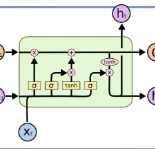The most common mental disorders experienced by a person in daily life are depression and anxiety. Social stigma makes people with depression and anxiety neglected by their surroundings. Therefore, they turn to social media like Twitter for support. Detecting users with potential depression and anxiety disorders through textual data is not easy because they do not explicitly discuss their mental state. It takes a model that can identify potential users who experience depression and anxiety on textual data to get treatment earlier. Text classification techniques can achieve this. One approach that can be used is LSTM as an RNN architecture development in dealing with vanishing gradient problems. Standard LSTM does not capture enough information because it can only read sentences from one direction. Meanwhile, Bidirectional LSTM (BiLSTM) is a two-way LSTM that can capture information without ignoring the context and meaning of a sentence. The proposed BiLSTM model is higher than all traditional machine learning models and standard LSTMs. Based on the test results, the highest accuracy obtained by BiLSTM reached 94.12%. This study has succeeded in developing a model for the detection of depression and anxiety in Twitter users.
翻译:一个人在日常生活中经历的最常见精神失常是抑郁和焦虑。社会污名使得人们被周围环境所忽视。因此,他们转向Twitter等社交媒体寻求支持。通过文本数据检测可能患有抑郁和焦虑症的用户并非易事,因为他们没有明确讨论其精神状态。它采用的模式可以识别在文本数据方面经历抑郁和焦虑的潜在用户,以便更早获得治疗。文本分类技术可以实现这一点。可以使用的一种方法是LSTM作为处理消失的梯度问题的RN结构开发的RSTM。标准的LSTM无法捕捉足够的信息,因为它只能从一个方向读到句子。与此同时,双向LSTM(BILSTM)是一个双向LSTM(B),它可以捕捉信息,而不会忽视其背景和意义。拟议的BILSTM模式比所有传统机器学习模型和标准LSTMs要高。根据测试结果,BLSTM获得的最高准确度达到了94.12%。这项研究成功地开发了在Twitter用户中发现抑郁和焦虑的模型。





